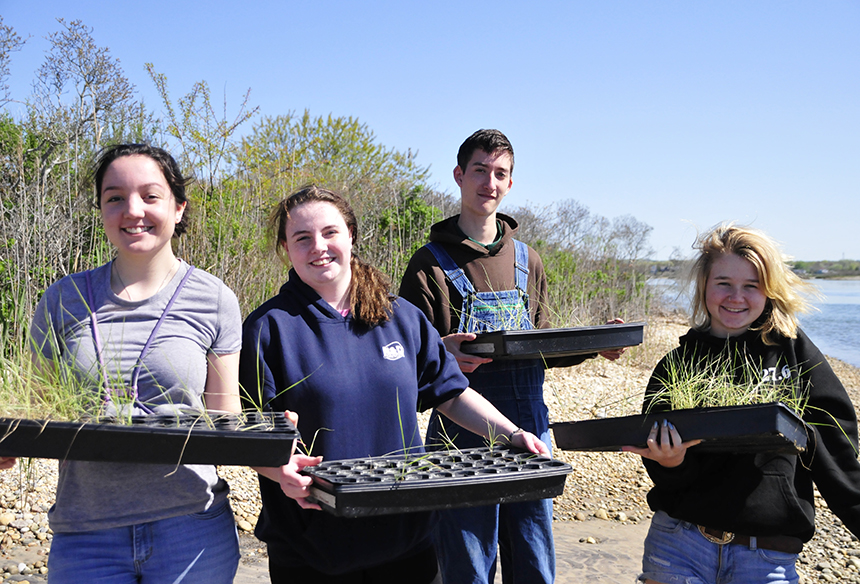By TODD McLEISH/ecoRI
News contributor
 |
| Chariho High School students are working to a restore a vulnerable marsh at Ninigret Pond. (Todd McLeish/ecoRI News) |
Sage Witham’s freshly
manicured fingernails were an elegant silver color, but they were covered in
mud and sand as she and her classmates worked to plant native grasses at a salt
marsh along the edge of Ninigret Pond.
The Chariho High School junior wasn’t concerned about a little mud on her nails, though.
The Chariho High School junior wasn’t concerned about a little mud on her nails, though.
“I had them done for
prom last week,” said Witham, a junior from Charlestown. “I don’t mind if they
get ruined now.”
The students gathered May
21 at the marsh with staff from Save The Bay, as part of
an extensive effort to restore the salt marsh, which had been drowning in place
because of rising sea levels.
The 30-acre site had
30,000 cubic yards of sandy sediments deposited on it 18 months ago, to raise
the elevation of the marsh and make it less vulnerable to the effects of
climate change. The sand had been dredged from the adjacent Charlestown
Breachway.
The resulting moonscape
was mostly devoid of vegetation, except for areas replanted by volunteers last
year and a few wild plants that successfully pushed through the new layer of
sediment. The students were aiming to expand that area of greenery to restore
the natural function of the marsh.
The school has been involved in the project for five years, collaborating with educators from Save The Bay to learn about the role of salt-marsh ecosystems.
They collect seeds from marsh grasses each fall and grow them into seedlings in the Chariho greenhouse each spring. Science teacher Stacie Pepperd uses the project in her agriculture and resource development classes to teach about alternative agricultural applications.
“This started as a small
experiment five years ago, and year by year we’re taking part in different
parts of the process,” she said. “The students are using their growing skills
and seeing that the agriculture industry is not just for growing vegetables and
other food products or ornamentals. This helps them see that there are
environmental applications, too.”
In February in the
Chariho greenhouse, the students planted about 1,000 seeds of cordgrass, a
common native plant that grows in the lower sections of salt marshes and
provides root structure that helps to stabilize the marsh and prevent erosion.
They cared for the plants daily, monitored their growth and vigor, and
transported them to the marsh for planting.
Sophomore Dalton Stone,
who works in the greenhouse, has a strong interest in plants and flowers and
envisions a career working with plant-based medicines or floral design.
“I like that we’re kind
of rebuilding the bay with this project by using grasses that have been
depleted because of storms,” the Richmond resident said. “I like that we’re
making a difference.”
The project isn’t just a
learning process for the students, however. It’s a learning process for Save
The Bay and its partners, too, as they use this new strategy to protect coastal
marshes.
“Every time we go out
there, we’re learning something new about the marsh and about what plants
survive where based on the new elevation of the site,” said David Prescott,
Save The Bay’s South County coastkeeper and the leader of the planting effort,
which is a partnership with the Rhode Island Department of Environmental
Management, the Coastal Resources Management Council, the Salt Ponds Coalition,
and the town of Charlestown.
Prescott then pointed to
a distant section of the site where he learned another lesson last year: unless
some sections of the newly planted marsh were fenced off, Canada geese would
feast on the fresh shoots.
According to the
National Oceanic and Atmospheric Administration, sea level has risen about 10
inches around Rhode Island since 1930, and it’s projected to rise another 20
inches by 2030 and as much as 9 feet by 2100. By
raising the elevation of the marsh by about a foot in some places, it buys time
to allow the habitat to migrate inland and adapt to the rising seas.
“Nine feet of sea-level
rise is going to have a devastating effect on the marsh habitat in the region,
but we’re trying to preserve the ecosystem function of the marsh for as long as
we possibly can and see if this technique is workable and transferable to other
locations,” Prescott said.
The students involved in
the replanting project have been enthusiastic about their role.
“They really like seeing
the success of the plants they’ve grown, but they also like seeing the
practical application of it,” Pepperd said. “This isn’t just your typical
garden or farm or flower pot or pretty flowers. This project has really opened
their eyes.”
Save The Bay is looking
for volunteers to continue the marsh-grass replanting effort on June 1, 2 and
4. Those who are interested may sign up online.
Rhode Island resident
and author Todd McLeish runs a wildlife blog.